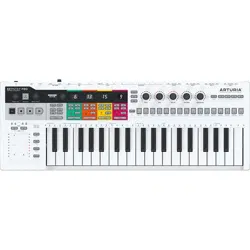Loading ...
Loading ...
Loading ...

5.3.2.3. Realtime Record
Holding down Record and pressing Play puts KeyStep Pro into Realtime Record mode.
Realtime recording will give a more fluent, natural feel to your sequence. In Realtime Record
mode, the sequencer will run at the speed you have set with the Tempo knob or the Tap
Tempo knob, and it will store whatever note or notes you are playing at each moment into
the currently active step. That makes it somewhat harder to predict in which step your key-
presses will be stored.
♪: In Realtime Record mode, if you hold down 'Shift' and press Record/Quantize, what you play will
automatically be quantized according to the current Time Division setting (see next sub-section).
!: When recording in Realtime Record mode, choosing a longer sequence length gives you more
space. To set the sequence to 64 steps, hold down Lst Step and press the 64 button.
There's a small problem with Realtime Record mode: it's difficult to know when you started
playing because you can't hear where the first step is. The solution is to turn on the
Metronome with 'Shift' + Metronome. When you press Play, the Metronome now starts
ticking, with the first step accented by a higher pitch. You can set the desired metronome
level (volume) with the retractable knob next to the Metronome output on the back panel of
the KeyStep Pro. To change the Time Division of the Metronome, hold Tap Tempo and press
one of the Time Division keys on the keyboard.
!: If the accent is not pronounced enough, make the first step louder by changing the metronome
settings in the Utility menu (Shift>Utility>Metronome) or in the MIDI Control Center.
The sequencer is now looping; the notes of any keys you press will be added to the loop.
The KeyStep Pro sequencers are polyphonic, so if you play a block chord instead of a single
note, all the notes of the chord will be entered into the currently active step of the loop. Of
course, if you want to hear all these notes, you must be in Poly mode.
The Tie/Rest button plays a key role in getting the sequence just right; while the sequence is
recording/looping, you can delete notes by holding the Tie/Rest button, while the button is
depressed it will erase the content of steps you're passing over.
♪: When recording in Realtime mode you can select another pattern on the fly to continue Recording
in that pattern.
Notice that all notes are recorded with the velocity at which you play them. Whether played
notes are
added
to the existing sequence or
replace
existing notes depends on the status of
the Overdub button to the left of the keyboard. It lights up when Overdub is ON.
How do you edit the individual notes and/or chords you've recorded in real time? It's simple:
press the Step Edit button (to the left of the step 1 button) and if you need advanced editing
options, like moving selected notes in a chord, you can also activate Overdub.
Arturia - User Manual Keystep Pro - Making Tracks 81
Loading ...
Loading ...
Loading ...
